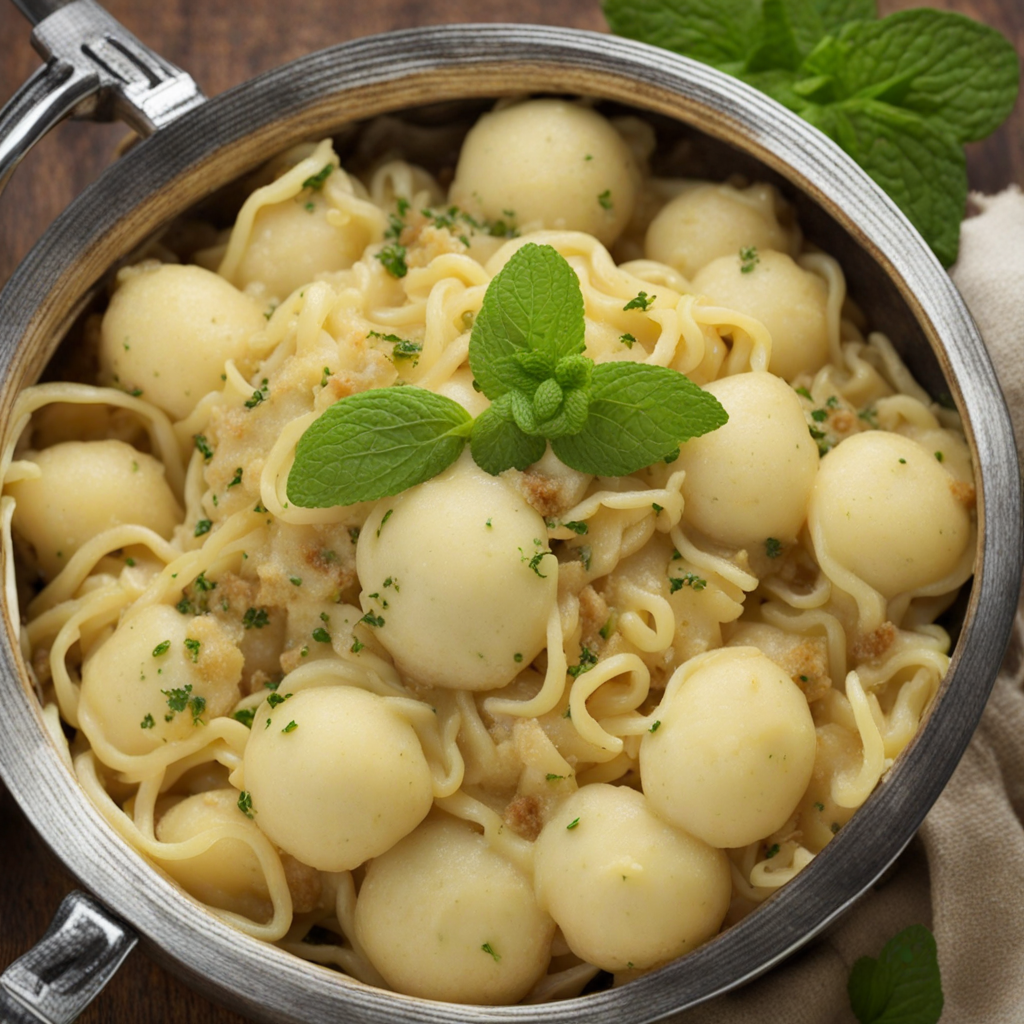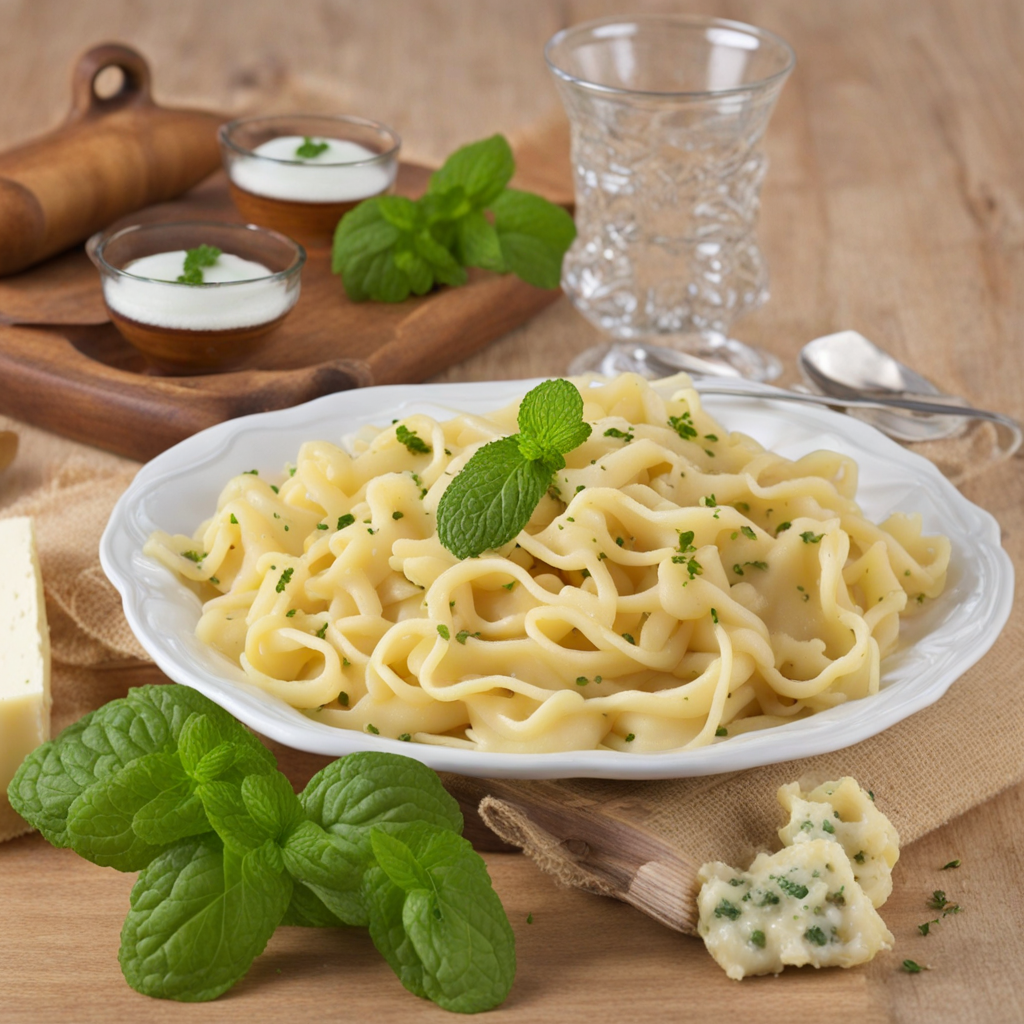Kärntner Kasnudeln
Kärntner Kasnudeln are a delightful specialty hailing from the scenic region of Carinthia in Austria. These delicious dumplings are made from a tender, thin dough that envelops a savory filling, primarily consisting of creamy cheese, typically a type of local curd known as "Bergkäse." The dough is often enriched with eggs, giving it a rich, golden hue and a slightly chewy texture that perfectly complements the smoothness of the filling. Each dumpling is meticulously shaped and sealed, making them both a feast for the eyes and the palate. The preparation of Kärntner Kasnudeln is an art form, with each dumpling crafted by hand. Traditionally, they are served with a generous drizzle of melted butter and garnished with crispy breadcrumbs or fresh herbs, enhancing the overall flavor profile. The contrast between the rich, creamy cheese filling and the light, buttery exterior creates a harmonious balance that is simply irresistible. Some variations may include added ingredients like potatoes or herbs, which further elevate the taste experience, offering a delightful twist on the classic recipe. Enjoying Kärntner Kasnudeln is not just about the food; it's about immersing yourself in Austrian culture and tradition. Often served as a main dish or a hearty side, these dumplings are a beloved comfort food that brings people together. As you savor each bite, you'll find yourself captivated by their unique taste and texture, making Kärntner Kasnudeln a must-try for anyone looking to explore the rich culinary heritage of Austria.
How It Became This Dish
Kärntner Kasnudeln: A Culinary Gem of Austria #### Origins and Historical Background Kärntner Kasnudeln, often simply referred to as Kasnudeln, are a traditional dumpling dish hailing from the picturesque Carinthia region of Austria. This delightful dish is characterized by its delicate dough, filled primarily with a mixture of soft cheese, potatoes, and various herbs. The origin of Kärntner Kasnudeln can be traced back to the 13th century, a time when the region was significantly influenced by various cultural and culinary traditions, including Slavic, Italian, and German influences. The Carinthian landscape, dotted with lush pastures and alpine meadows, provided an abundance of dairy products, particularly cheese. The local farmers and shepherds, needing hearty yet portable meals, began to craft these dumplings as a means to utilize available ingredients. The name "Kasnudeln" is derived from the German word "Käse," meaning cheese, and "Nudeln," which translates to noodles or dumplings, underscoring the primary ingredient and the form of the dish. #### Cultural Significance Kärntner Kasnudeln are more than just a meal; they embody the spirit and traditions of the Carinthian people. They are often associated with local festivals, family gatherings, and celebrations, marking significant moments in the community. The preparation of Kasnudeln is often a communal activity, where families come together to make the dough, prepare the filling, and shape the dumplings, fostering a sense of unity and shared heritage. In Carinthia, these dumplings are traditionally served during special occasions, particularly during the time of Lent and other religious festivals. They are often accompanied by a simple butter sauce, sprinkled with fried onions or served with a side of sauerkraut, complementing their rich and savory flavors. The dish has become a symbol of regional pride, representing the agricultural bounty of the area and the culinary creativity of its inhabitants. #### Development Over Time As with many traditional dishes, Kärntner Kasnudeln have evolved over the centuries. Initially, the filling was quite simple, relying heavily on the local soft cheeses made from cow's milk, such as "Schwarzenegger" cheese, a creamy and tangy cheese that offers a distinct flavor. Over time, variations of the filling emerged, incorporating potatoes, onions, and herbs like chives, parsley, and dill. This adaptability highlights the dish's connection to local agriculture and the seasonal availability of ingredients. In the 19th and 20th centuries, as Carinthia became more integrated into the broader Austrian and European culinary scenes, Kasnudeln began to gain popularity beyond their regional confines. This period saw the introduction of new flavor profiles and the incorporation of modern cooking techniques. For instance, while the traditional method involved boiling the dumplings, the advent of steaming and frying has added new dimensions to how Kasnudeln can be enjoyed. The dish's recognition grew not only within Austria but also internationally, particularly as Austria's culinary reputation expanded in the late 20th century. Today, Kärntner Kasnudeln are celebrated in Austrian restaurants and increasingly featured in culinary events and festivals. In 2016, the dish was officially recognized as a "traditional specialty" (TSG) by the European Union, which aimed to protect and promote regional foods across Europe. This designation helped solidify its status as a culinary icon of Carinthia, encouraging chefs to honor traditional recipes while also inspiring innovative interpretations. #### Modern Interpretations and Global Influence In contemporary Austrian cuisine, Kärntner Kasnudeln are often showcased in both traditional and modern settings. Chefs have begun to experiment with fillings, incorporating not only the classic cheese and potato mixture but also seasonal ingredients such as spinach, pumpkin, or even wild mushrooms. This experimentation reflects a broader trend in global cuisine, where chefs seek to marry traditional flavors with innovative techniques and presentations. The accessibility of Kärntner Kasnudeln has also increased with the rise of culinary tourism. Visitors to Carinthia often seek out local specialties, and cooking classes focused on Kasnudeln have become popular, allowing tourists to engage directly with the culinary heritage of the region. This interaction not only fosters appreciation for traditional cooking methods but also encourages the preservation of recipes that might otherwise fade away. Furthermore, the dish has found its way into the hearts of food enthusiasts beyond Austria. With the advent of social media and cooking shows, Kärntner Kasnudeln have been featured on platforms that celebrate regional cuisines, inspiring home cooks around the world to recreate this Austrian delicacy in their kitchens. The rise of food blogs and YouTube channels dedicated to international cuisines has led to a renewed interest in traditional dishes like Kasnudeln, encouraging a new generation to appreciate and preserve culinary heritage. Conclusion Kärntner Kasnudeln are not merely a dish; they are a testament to the rich cultural tapestry of Carinthia and its people. From their humble beginnings as a practical meal for farmers to their rise as a celebrated culinary specialty, these dumplings encapsulate the essence of Austrian hospitality and the importance of food in cultural identity. As they continue to evolve and adapt in response to modern culinary trends, Kärntner Kasnudeln remain a beloved symbol of Carinthian tradition, inviting both locals and visitors alike to savor the flavors of this enchanting region. Through each bite, one can experience the history, culture, and passion that have shaped this remarkable dish over the centuries.
You may like
Discover local flavors from Austria







